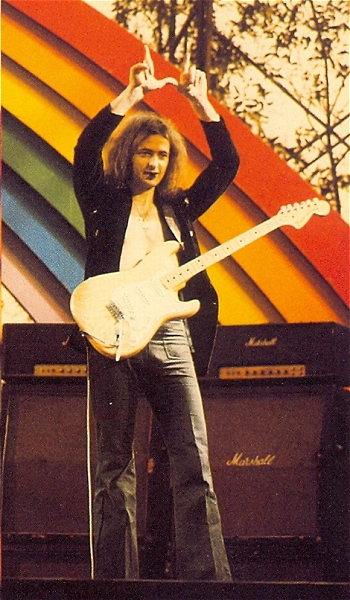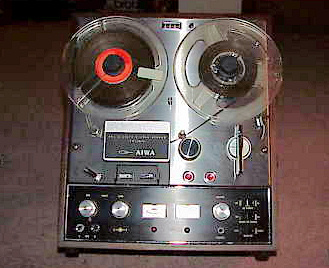Ritchie Blackmore´s Mk3 sound

Ritchies sound during his DP_Mk3 times, is an interesting subject on its own. Until 1973, Ritchie used the treblebooster in front of his Marshall Major amp during his DP_Mk2 period. With David Coverdale and Glenn Hughes as a substitute for Ian Gillan and Roger Glover in late 1973, Ritchie was the one and only leader of DP_Mk3. He wanted to use an echoe effect for his live performances, but sadly he did not found anything to taylor his needs and after trying numerous echoe devices, he ended up with his home-based AIWA TP-1011 tape recorder - he did not like the well-known and common tape-echoe machines of this time like the Echoplex or the WEM Copycat. In a nutshell, this specific AIWA machine was nothing fancy, just a simple budget 3-head tape recorder and not even in the same ballpark, compared to the top of the line models of this time from japanese manufacturers like Sony, AKAI, TEAC and Dokorder, the US-made Ampex or the famous swiss-made REVOX machines - Ritchie tried almost all of them ! The main AIWA products at this time were handheld dictaphones and small budget tape recorders. Besides this, AIWA also offered some "real" 7-inch open-reel machines, to compete with the other companies. Some of this machines were battery-powered, some others offered a built-in amplifier and small speakers - all typical things at the late 60´s. The TP-1011 (with a tape speed of 19cm/sec.) was the only useable machine from AIWA at this time for hi-fi purposes. But the inexpensive AIWA machine contained a need feature, that not all three-head machines had: the socalled "Sound-on-Sound" switch (aka "SOS switch"), providing an echoe effect by pushing a button. Adjusting the "Repeat" time was always a challenge, beacause the only way to do that, was to use the tape-speed: 19cm/sec. - 9.5cm/sec. - 4,75cm/sec. which was a 1/3 sec. or a 2/3 sec. delay that raised Ritchie´s attention. At DP Mk3 Ritchie used the 1/3 sec. delay exclusively, later on with "Rainbow" he used the 2/3 sec. delay as well. To bust some myths and urban-legends ..... the AIWA TP-1011 was not tube-powered and it also did not contain any germanium transistors - the whole machine was pure silicone powered!

But by accident, the AIWA´s mic pre-amp stage worked perfectly together with Fender-style pickups. Because a guitar pickup is not a microphone, that´s not always the case and depends on the specific tape machine. There are many tape machines (independent from the manufacturer, price and model) which did not work together with a guitar pickup, connected to the mic pre-amp input, so it was pure luck that it worked with the AIWA and Ritchie really liked this sound. As a downside, the AIWA did not work with Ritchie´s Hornby-Skewes treblebooster in front of the machine, the result was a very distorted and noisy tone. In autumn 1973 Ritchie contacted the technicians from the Marshall company again, still happy about the job they did by cascading his pre-amp stage. This time they had to modify the AIWA tape recorder so it perfectly matches the Major amp and Ritchie´s new sound ideas and again they did a great job. While auditioning the modified amp in the Marshall factory (maybe not at maximum gain ?!?) Ritchie really liked this new powerful and dirty sound. He used this amp for the US "Burn" tour in spring 1974. There are two recordings, where you can hear this sound: "California Jam" and "Perks and Tit" (aka "San Diego 1974"). But the modified amp also had a downside: the DP_Mk3 stage level was incredibly high and the new, highly motivated bassplayer Glenn Hughes was new a member of the "greatest rockband of the world" ... and he knew that ! So he started to use Hiwatt 200 amps with 4 x KT88 power tubes and big bass-bins (built for PA purposes) to hold-up with Ritchies high volume level. So Ritchie had the problem, that he had enough power and volume, but he needed more bite to cut through the mix. With maximum gain, his sound was way to mild, not as agressive and powerful as in the past with the treblebooster in front of the amp. This problem only occured at maximum gain, not below, because of uncompensated saturation-effects of the amp´s power stage, caused by the additional gain. Soon after the US tour he went to the Marshall factory again to get rid of this problem, because the England tour was soon to come, starting in Scotland. To bust some myths again: Ritchies Lead Major amp still had 4 KT88 power tubes !!! This UK tour is documented as "DP Live in London" from May 1974, recorded by BBC. Ritchies new sound was tight, razor-sharp and with a lot of bite. At the same time he stopped playing the ultra-fat chords from the US tour you can hear on the "Perks and Tit" record in the "Burn" song and he started to play unisone single notes - this was one of the results of his new sound ! Ritchie played this amp without any new mods for the rest of his DP_Mk3 period. You can hear this sound on "Made in Europe" and the later "Mk III Final Concerts" and "Live in Paris 1975", all of them recordings from the last three DP Mk3 concerts, short before Blackmore left Deep Purple.
It is also from interest that RB´s tech changed later in Rainbow the stock driver tube ECC82 to the military high quality “JAN” tubes 5814A or 6189W.
In closing, some words about Ritchies 72´ash-bodied Strat he played during his DP_Mk3 times. If you want to nail this specific Ritchie sound, it´s important to use a close copy of this axe. Especially the one-piece diecast tremolo with the diecast saddles (a typical, stock feature of the Fender 70´s Strats) is important for the tone, it´s more or less impossible to get this tone with the vintage steel tremolo and the steel saddles. It´s difficult to get such a diecast tremolo today, but a good compromise are the diecast saddles from the Fender "Squier" series - this are easy to find and you can interchange them 1:1 with the vintage steel saddles. The MIM "Fender Classic 70s Strat" with ash body and maple neck (model 013 7002, color #21, natural), is the best bang for the buck and a very good starting point for further modifications. Even the stock pickups of this guitar are perfect for all Blackmore things. The only gripe is the typical Fender tremolo with vintage saddles and screwed inertia bar, but as stated earlier .... this is easy to modify.